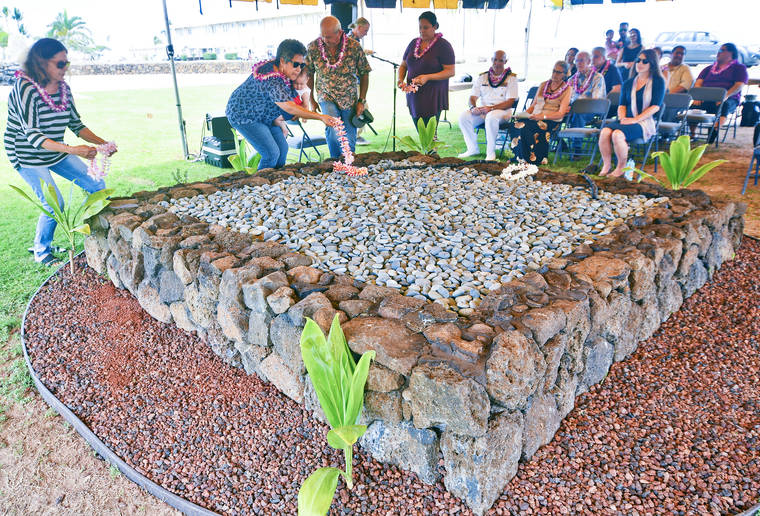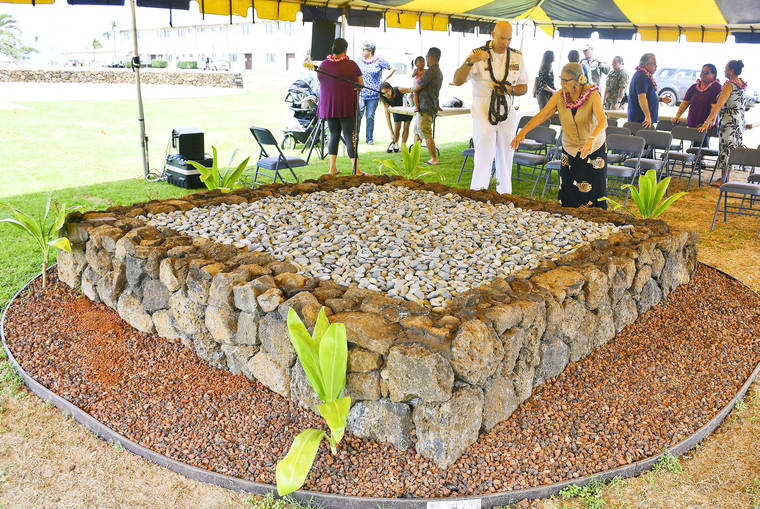A place to rest


BARKING SANDS — Every winter, big swells uncover human bones in the sand along Kauai’s Westside, and those iwi, or bones, found at the U.S. Navy Pacific Missile Range Facility now have a new resting place.
Dedicated in the full sun of high noon on the summer solstice, a stone crypt now sits on the grounds of PMRF. In Hawaiian tradition, the summer solstice is one of the most important days of the year.
For Friday’s ceremony, the base hosted families that trace their ancestry to the place, as well as members of the Kauai/Niihau Burial Council, the archaeologist who has been working with the family, and base Commanding Officer Capt. Vincent Johnson.
After an opening prayer by Aletha Kaohi, Johnson welcomed the group with an oli (prayer), and then opened up the floor for the Kilauano family.
“We are very thankful,” said Vida Mossman, who made a short speech on behalf of the Kilauano family. “We hope this sets an example for future projects on the island. It’s so very beautiful.”
The crypt, a stone square about two feet high and measuring about eight feet by eight feet, is covered by a heavy lid that is removed once a year on the summer solstice. The lid is covered with loose rocks.
Throughout the year, iwi that are discovered are held in a temporary crypt until that auspicious day, when the family is present and gives the go-ahead to open the crypt.
Situated near a historic Japanese cemetery and the Missile Defense Viewing Site, the crypt is a place where families can visit frequently.
“We worked in concert with the families,” said archaeologist Carly Antone. “This place provides accessibility, it’s within sight of the dunes and near the ocean and, logistically, it’s close to irrigation, so we can take care of it.”
While the first choice is to keep the kupuna iwi where they are, Native Hawaiian and archaeologist Missy Kamai said a crypt is a good second, safe resting place.
Kauai/Niihau Burial Council representative Keith Yap echoed Kamai.
“It’s about the right thing to do for the iwi,” Yap said. “If they need to be moved, we want to put them in a safe place, and that’s the crypt.”
After prayers, speeches and mana‘o from several in attendance, members of the Kilauano family placed lei on the crypt and took a moment to honor the iwi.
Then, PMRF staff broke out the food and served lunch.
“This is a tribute to what can be done between the military and our Hawaii family,” Kaohi said. “The dead is very much a part of the family.”
•••
Jessica Else, environment reporter, can be reached at 245-0452 or jelse@thegardenisland.com.



This is a beautiful ahu, but an even more beautiful concept. U.S. military cooperating respectfully with local families to provide a place honoring their ancestral bones which were inadvertently uncovered from the disturbance of sand dunes by winter weather. Unlike what’s happening on Mauna Kea, where hooligans build politically-inspired rockpiles to block roads and construction sites; and then call the rockpiles “ahu” as though they deserve the respect rightly given to altars built to honor spiritual values.